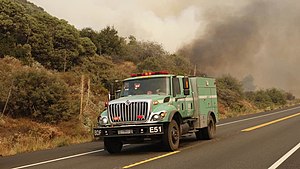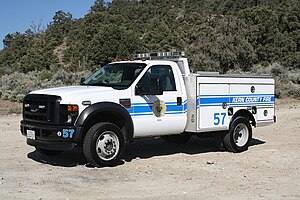
A wildland fire engine or brush truck is a fire engine specifically designed to assist in fighting wildfires by transporting firefighters to the scene and providing them with access to the fire, along with water or other equipment. There are multiple types of wildfire apparatus which are used in different scenarios. According to the U.S. National Fire Protection Association, if the apparatus will be used primarily for outdoor and wildland responses, then it is to be considered a wildland fire apparatus and must conform to NFPA 1906.
Depending on where the engine is stationed, it may carry as much as twice the national standard in fire hose. In areas where there is rugged terrain that keeps engines from driving directly to the fire, large hose lays are installed to transport water to the fire area. In areas with moderate terrain less hose is used as it is easier to access the fire. Often the hose-free technique of pump-and-roll is used where the vehicle drives with the pump engaged while a firefighter uses a hose to spray water on the fire. This technique allows a team of two to flank the perimeter of a fire.
Features
Wildland engines are traditionally smaller than standard fire engines and are primarily used for wildfires. They also respond to emergencies in the back country where traditional engines cannot respond. Most wildland engines feature four-wheel drive capability and can thus climb hills and make it through rough terrain. One of the features that makes these engines ideal for vegetation fires is that they can pump water while driving, whereas most, but not all traditional engines must be put into park to flow water, it depends on the specifications to which the Fire Department wants the vehicle to be built. This pump-and-roll feature allows the engines to make "running attacks" on vegetation fires, a tactic that can help minimize the rate of spread by having a firefighter walk the edge of a fire with a hose line and the engine trailing close behind.
Engine types
In the fall of 2007, the National Wildfire Coordinating Group agreed on a set of standards for fire engines used for wildland firefighting in the United States. As structure engines are sometimes used on wildland fires, though primarily for structure protection, they are also included in the NWCG engine typing. Per the standards there are 7 types of fire engines.
| Engine Type | |||||||
|---|---|---|---|---|---|---|---|
| Structure | Wildland | ||||||
| Requirements | 1 | 2 | 3 | 4 | 5 | 6 | 7 |
| Minimum tank capacity | 300 US gal (1,100 L; 250 imp gal) | 300 US gal (1,100 L; 250 imp gal) | 500 US gal (1,900 L; 420 imp gal) | 750 US gal (2,800 L; 620 imp gal) | 400 US gal (1,500 L; 330 imp gal) | 150 US gal (570 L; 120 imp gal) | 50 US gal (190 L; 42 imp gal) |
| Minimum flow rate USGPM (L/S IMPGPM) |
1,000 (63; 830) | 500 (32; 420) | 150 (9.5; 120) | 50 (3.2; 42) | 50 (3.2; 42) | 50 (3.2; 42) | 10 (0.63; 8.3) |
| Minimum pressure | 150 psi (1,000 kPa) | 150 psi (1,000 kPa) | 250 psi (1,700 kPa) | 100 psi (690 kPa) | 100 psi (690 kPa) | 100 psi (690 kPa) | 100 psi (690 kPa) |
| Hose types | |||||||
| 2-1⁄2" | 1,200 ft (370 m) | 1,000 ft (300 m) | — | — | — | — | — |
| 1-1⁄2" | 500 ft (150 m) | 500 ft (150 m) | 1,000 ft (300 m) | 300 ft (91 m) | 300 ft (91 m) | 300 ft (91 m) | — |
| 1" | — | — | 500 ft (150 m) | 300 ft (91 m) | 300 ft (91 m) | 300 ft (91 m) | 200 ft (61 m) |
| Pump and Roll | Sometimes | Sometimes | |||||
Type 3

The Type 3 Engines traditionally have four-wheel drive to make driving over rough terrain easier; they can also be produced with standard rear wheel drive. Additionally the cab can either be two- or four-door holding up to five people, but no fewer than three. Almost all Type 3s have four doors as a crew size of five is optimum. Type 3s are required to have a minimum of 500 US gallons (1,900 L; 420 imp gal) of water, and be able to pump 150 US gallons per minute (9.5 litres per second; 120 imperial gallons per minute) at a pressure of 250 pounds per square inch (1,700 kPa). They have a typical GVWR of 26,000 pounds (12,000 kg). The Type 3 is the most popular engine in California due to the difficult road access to wildland fires; Type 3 engines typically have a shorter wheelbase allowing tighter turns on forest roads.
Type 4
The Type 4 engine trades a smaller pump and less hose for a 50% larger tank. It is required to carry a minimum of 750 US gallons (2,800 L; 620 imp gal) of water, but only pump 50 US gallons per minute (3.2 litres per second; 42 imperial gallons per minute) at a pressure of 100 pounds per square inch (690 kPa). The typical GVWR is at least 26,000 pounds (12,000 kg).
Type 5
Type 5s are normally used as an initial attack engine atop a medium duty chassis. The GVWR of the chassis is around 20,000 pounds (9,100 kg).
Type 6

Type 6 Engines are built on a pickup truck frame with a medium duty chassis giving a GVWR of 9,000–16,000 pounds (4,100–7,300 kg). They are required to carry a minimum of 150 US gallons (570 L; 120 imp gal) of water, but only pump 50 US gallons per minute (3.2 litres per second; 42 imperial gallons per minute) at a pressure of 100 pounds per square inch (690 kPa). In California these engines are staffed with one firefighter and used for patrols; for this reason the unit itself is sometimes called a patrol truck or simply "patrol". Most other dispatch areas require the Type 6 to have a minimum of 3 personnel (required by NWCG policies), and is more popular outside of California due to its ability to go where other engines cannot.
Type 7 – Prevention Module
Type 7 are patrol vehicles with a small pump and tank. As a light duty vehicle, they are in the range of 6,500–10,000 pounds (2,900–4,500 kg) GVWR. The vehicle has a small 50 US gallons (190 L; 42 imp gal) water tank and can pump 10 US gallons per minute (0.63 litres per second; 8.3 imperial gallons per minute) at a pressure of 100 pounds per square inch (690 kPa). It is a multipurpose unit used for patrol, mop up, or initial attack.
NFPA 1906
Additionally, there are requirements laid out by the National Fire Protection Association in NFPA 1906: Standard for Wildland Fire Apparatus. Some of the many details of the NFPA 1906 include:
- Stability: All vehicles must pass a 30° stability test.
- Roadability: Vehicles must be capable of operating on 20% grades and remaining stationary on 10% grades.
- Carrying Capacity: The Standard lays out a detailed analysis of what the allowable additional weight is on top of the gross vehicle weight rating. This is critical to keep the vehicles from getting overweight.
- Pump-And-Roll: Vehicles must be able to deliver 20 gpm at 80 psi while moving at a speed of 2 mph
References
- ^ David, Haston. "NFPA 1906 and Wildland Apparatus Design". US Forest Service. Archived from the original (PDF) on 3 August 2014. Retrieved 6 January 2014.
- Engine Boss, S-231. NWCG. 2004.
- Fire Fighter Training, S-130. NWCG. 2003.
- "Type 3 Engine" (PDF). Santa Barbara County Fire. Archived from the original (PDF) on 31 December 2013. Retrieved 30 December 2013.
- ^ "Engine Types" (PDF). National Wildfire Coordinating Group. Archived from the original (PDF) on 1 May 2015. Retrieved 5 January 2014.
- "Wildland Type III". Ferrara Fire. Archived from the original on 26 September 2013. Retrieved 15 January 2014.
- "Engines". National Park Service. Retrieved 15 January 2014.
- ^ "USDA Forest Service Wildland Fire Engine Guide" (PDF). United States Department of Agriculture. p. 4. Retrieved 15 January 2014.
- "Kern County Firefighters at station 72 receives(sic) brand-new equipment". 23 ABC News Bakersfield. Sep 1, 2017. Retrieved 2 September 2017.
- NFPA 1906: Standard for Wildland Fire Apparatus (2012 ed.), National Fire Protection Association